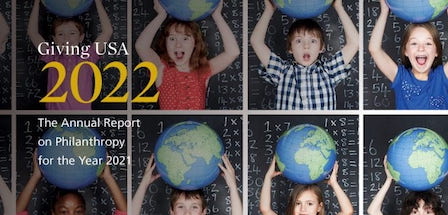What We Can Learn from Giving USA 2022
What We Can Learn from Giving USA 2022
 by Ronnie Plasters
by Ronnie Plasters
Though Americans did not produce a record-breaking year in 2021, generosity outpaced pre-pandemic levels according to the recently released findings of Giving USA. While those of us at Lake Institute may quickly note the $136 billion given to the religious sector (a 1% increase over last year), as a former director of development for a prominent theatre company, I noticed the 22% increase over last year in giving to arts, culture, and humanities. Last year, this sector decreased while many others remained steady. However, as doors began to open, exhibits returned, and stages lifted the curtain, citizens responded—emphatically and dramatically!
Return of In-Person Gatherings
There exists an interesting parallel for those of us in religious spaces when reflecting upon this year’s religious giving data. Though 2021 witnessed several intersecting events, two of these activities significantly impacted the trends in religious giving. The first major change from 2020 to 2021 revolved around physical gatherings. Even though the pandemic continued, the return of in-person worship brought increased giving that stabilized budgets for many houses of worship. Last year’s Giving USA report demonstrated the importance of virtual engagement for religious communities. In fact, giving to religion remained prevalent in 2020 thanks largely to online platforms that allowed for virtual gatherings and giving.
The continuation of the pandemic into 2021 affirmed these findings even as additional insights emerged. Most significantly, religious givers value regular invitations to give. Where some adopted a field of dreams mentality, “build it and they will come,” or a “silver bullet” solution, the truth is that when it comes to online giving, houses of worship must adopt virtual options while continuously engaging participants regularly. It sems that passing the plate—even if symbolic—proves exceptionally meaningful. This truth is especially pertinent for Protestant communities as verified by Givelify and the Evangelical Council for Financial Accountability.
Continued Social Unrest
In addition to in person gatherings, the second major event of 2020 included the intense social unrest that cut across communities, growing into national movements. Many faithful communities responded with bold generosity. In fact, this impressive response of the religious community included multiple faith traditions that reflected a collective religious engagement. For example, Transformation Church in Tulsa marked Juneteenth with a $1 million gift to Tulsa Race Massacre survivors; Trinity Church Wall Street gifted $21 million to a myriad of nonprofits working to end cycles of mass incarceration and homelessness; the Church of Jesus Christ of Latter-day Saints is donating nearly $10 million in partnership with NAACP for educational and humanitarian causes; The American Muslim Community Foundation distributed nearly $1.3 million to more than 150 charities in alignment with shifting giving priorities in support of civil rights and justice movement in the US; and the Lilly Endowment invested over $83 million to serve marginalized communities and to support the training of diverse pastors. These stories are matched by many localized efforts in churches, mosques, and a myriad of faithful communities across the US.
Engagement is Key
Overall, 2021 witnessed increased giving across the US which includes giving to and by religious organizations. The continuing role of online engagement cannot be dismissed by religious leaders as it empowers individuals to easily and effectively respond to their house of worship’s invitation to give. The return to physical gatherings enhanced this virtual giving trend and helped reveal the role and value of online giving platforms now and into the future. A healthy community is one that actively engages members while providing them efficient and easy modes to share their generosity. Moreover, the role religious organizations played and continue to play in response to marginalization motivates and inspires religious participants.
As the pandemic lingers and social distress continues—and as we embrace new, unforeseen hurdles—it remains pertinent for faith communities to engage. This engagement cannot only be virtual or physical; it must be both. Further, houses of worship and religious organizations must engage in their local spaces even as they respond to civil unrest that cuts across a diverse citizenry and geography. In fact, as noted in the response that follows from Anna Pruitt and Jon Bergdoll, individuals continue to give the most, with foundations and corporations trailing. It is from everyday citizens that the generous impulse of our nation beats fervently. As a religious community, we acknowledge and celebrate that giving to religion remains a leading segment. Therefore, we have a responsibility and great challenge to continually inspire our communities to live generously. While no one can predict the future, those organizations that embrace the hybridity of physical-virtual along with local engagement that honors a national ethos will continue to generate impressive, inspiring results.
Questions for Reflection
- Where do you see your organization reflected in this data?
- What can you take away from Giving USA 2022 to enhance the work of your organization?
Expanded Perspective

Anna Pruitt and Jon Bergdoll, two of the lead researchers of the Giving USA 2022 report, found that inflation changed how far each charitable dollar went in 2021. They also saw that a significant percentage of giving came from extremely large gifts and that many charities whose 2020 donations declined may have experienced a rebound. This article from The Conversation is a great summary highlighting what our colleagues at the IU Lilly Family School of Philanthropy found in 2021.
Summer Office Hours Return
 Our first topic for Summer Office Hours will be Getting Started with Legacy/Planned Gifts. Our friends at Cooperative Baptist Fellowship will share a few resources they’ve created, then we’ll open the floor for questions and conversation. We hope you’ll join us each Wednesday in July for these virtual roundtable exchange of ideas!
Our first topic for Summer Office Hours will be Getting Started with Legacy/Planned Gifts. Our friends at Cooperative Baptist Fellowship will share a few resources they’ve created, then we’ll open the floor for questions and conversation. We hope you’ll join us each Wednesday in July for these virtual roundtable exchange of ideas!
Register today
Remaining ECRF Courses in 2022

In a few months we’ll release our 2023 ECRF dates. However, there are still a few opportunities to join us in the Executive Certificate in Religious Fundraising course this year! In August we have a hybrid version – starting with online work before gathering together in Indianapolis for three days, then concluding with online work after you return home. In October we’ll host another offering of our eight-week online version. Both include a practical application project that provides the research, tools and customized training to meet the growing needs of leaders in religious communities and fundraisers of faith-based organizations.
Subscribe
Insights is a bi-weekly e-newsletter for the religious community and fundraisers of faith-based organizations that provides:
- Reflections on important developments in the field of faith and giving
- Recommended books, studies and articles
- Upcoming Lake Institute events
